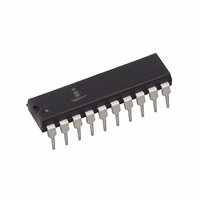CP82C89Z Intersil, CP82C89Z Datasheet - Page 2

CP82C89Z
Manufacturer Part Number
CP82C89Z
Description
IC ARBITER BUS 5V 8MHZ 20-DIP
Manufacturer
Intersil
Datasheet
1.CP82C89Z.pdf
(13 pages)
Specifications of CP82C89Z
Controller Type
CMOS Priority Interrupt Controller
Voltage - Supply
4.5 V ~ 5.5 V
Current - Supply
1mA
Operating Temperature
0°C ~ 70°C
Mounting Type
Through Hole
Package / Case
20-DIP (0.300", 7.62mm)
Lead Free Status / RoHS Status
Lead free / RoHS Compliant
Interface
-
Available stocks
Company
Part Number
Manufacturer
Quantity
Price
Company:
Part Number:
CP82C89Z
Manufacturer:
Intersil
Quantity:
80
Functional Diagram
Pin Description
ANYRQST
S0, S1, S2
SYMBOL
CRQLCK
LOCK
RESB
GND
V
AEN
CLK
INIT
PIN
IOB
CC
NUMBER TYPE
STRAPPING
1, 18-19
CONTROL/
OPTIONS
20
10
17
16
15
14
13
STATUS
4
2
6
80C86/
80C88
O
I
I
I
I
I
I
I
I
ANYRQST
CRQLCK
2
V
GROUND.
STATUS INPUT PINS: The status input pins from an 80C86, 80C88 or 8089 processor. The 82C89 decodes
these pins to initiate bus request and surrender actions. (See Table 1).
CLOCK: From the 82C84A or 82C85 clock chip and serves to establish when bus arbiter actions are initiated.
LOCK: A processor generated signal which when activated (low) prevents the arbiter from surrendering the multi-
master system bus to any other bus arbiter, regardless of its priority.
COMMON REQUEST LOCK: An active low signal which prevents the arbiter from surrendering the multi-master
system bus to any other bus arbiter requesting the bus through the CBRQ input pin.
RESIDENT BUS: A strapping option to configure the arbiter to operate in systems having both a multi-master
system bus and a Resident Bus. Strapped high, the multi-master system bus is requested or surrendered as a
function of the SYSB/RESB input pin. Strapped low, the SYSB/RESB input is ignored.
ANY REQUEST: A strapping option which permits the multi-master system bus to be surrendered to a lower
priority arbiter as if it were an arbiter of higher priority (i.e., when a lower priority arbiter requests the use of the
multi-master system bus, the bus is surrendered as soon as it is possible). When ANYRQST is strapped low, the
bus is surrendered according to Table A in Design Information. If ANYRQST is strapped high and CBRQ is
activated, the bus is surrendered at the end of the present bus cycle. Strapping CBRQ low and ANYRQST high
forces the 82C89 arbiter to surrender the multi-master system bus after each transfer cycle. Note that when
surrender occurs BREQ is driven false (high).
IO BUS: A strapping option which configures the 82C89 Arbiter to operate in systems having both an IO Bus
(Peripheral Bus) and a multi-master system bus. The arbiter requests and surrenders the use of the multi-master
system bus as a function of the status line, S2. The multi-master system bus is permitted to be surrendered while
the processor is performing IO commands and is requested whenever the processor performs a memory
command. Interrupt cycles are assumed as coming from the peripheral bus and are treated as an IO command.
ADDRESS ENABLE: The output of the 82C89 Arbiter to the processor’s address latches, to the 82C88 Bus
Controller and 82C84A or 82C85 Clock Generator. AEN serves to instruct the Bus Controller and address latches
when to three-state their output drivers.
INITIALIZE: An active low multi-master system bus input signal used to reset all the bus arbiters on the multi-
master system bus. After initialization, no arbiters have the use of the multi-master system bus.
CC
LOCK
RESB
CLK
IOB
: The +5V Power supply pin. A 0.1µF capacitor between pins 10 and 20 is recommended for decoupling.
S 2
S 1
S 0
ARBITRATION
DECODER
CONTROL
STATUS
+5V
82C89
INTERFACE
INTERFACE
MULTIBUS
DESCRIPTION
LOCAL
GND
BUS
MULTIBUS™ is an Intel Corp. trademark.
INIT
BCLK
BREQ
BPRN
BPRO
BUSY
CBRQ
AEN
SYSB/
RESB
SYSTEM
SIGNALS
MULTIBUS™
COMMAND
SIGNALS
February 27, 2006
FN2980.2












